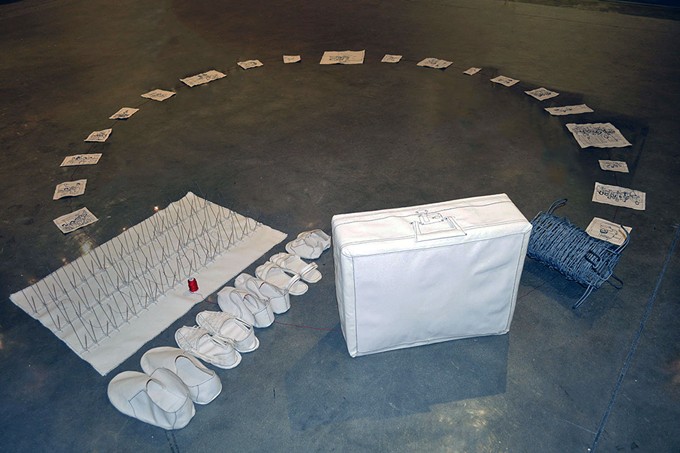The day I stopped in the Bernal Gallery at Pima College West Campus turned out to be the same day Russia began attacking the Ukraine.
Ukraine President Volodymyr Zelenskyy reported a harrowing 137 dead that first day; one of the casualties was believed to be a small child. The senseless loss of life was horrifying. And more is to come.
As it happens, the two shows at the gallery that I went to see are about violence and cruelty. The artists don’t need to go to beleaguered central Europe to denounce evil: in their works, they unveil the ugly sides of human beings right here in Arizona.
Photographer Wayne Gudmundson’s project, What Place Is This, goes far back in time. Working with historian Dieter Berninger, Gudmundson went to the locations of 21 long-ago battles and massacres in the countryside outside early Tucson. The mayhem was typically between native peoples and white European newcomers, but local tribes often fought against each other as well. The photos he made of these places of slaughter are haunted by the long dead.
Textile artist Perla Segovia’s installations, Threads of Immigration, are up to the minute. Her work in canvas and embroidery laments the United States’ inhumane treatment of desperate migrants and refugees fleeing from violence, drought and poverty. The cages-for-kids she makes denounce the 2018 Trump policy of snatching small migrant children away from their mothers or fathers.
The work of these Tucson artists “bring a conversation about people immigrating to Southern Arizona recently and historically,” says gallery director David Andres. “That conversation starts over 300 years ago,” when Spanish soldiers and padres arrived.
Gudmundson, a retired professor at Minnesota State University, and an artist with photos in in MOMA New York and at the Center for Creative Photography, shot a picture for each location; Berninger, wrote a text for each photo.
The pair traveled from Baboquivari to the San Pedro, examining sites from 1698 to 1882 and within a 60-mile radius of Tucson. It’s unsettling to learn about the bad things that happened at beloved places—Arivaca, Tubac, Madera Canyon and on and on. There’s even a double murder on Convent Street.
The earliest rampage story that Gudmundson and Berninger collected took place by the San Pedro River, near Fairbank, now a ghost town. It was 1698, in a place called Gaybanipitea. A band of about 80 Sobaipuri-O’odham were attacked by five native groups, including the Apache. The locals were helped by allies, but five of the Sobaipuri-O’odham people died. Oddly, some of the white newcomers, including Father Kino, witnessed the melee.
Scholars suspect that attackers in raids like these were looking for food or goods and possibly captives, Berninger writes. And the emergence of the newcomers disrupted native cultures, spread dangerous illnesses and sometimes left the natives bereft of food and water.
A more deadly fight took place nearly 200 years later at Baboquivari, the peak sacred to the Tohono O’odham. Settlers were trying to poach on O’odham land, and the precious water in the creek at the base of the mountain. In 1841, Mexican authorities sent 600 soldiers to end the dispute. Forty O’odham people died on their own on ancestral land.
The infamous massacre of 1871 at Camp Grant of took the lives of 144 Apache, most of them women and children. The brutal attack came after this Apache band had agreed with U.S. authorities to live peacefully and to raid no more, Nevertheless, a gang from town— whites, Hispanics, Tohono O’odham— came when the menfolk were away hunting, and butchered the wives and children of their enemies, lying mutilated in beautiful Aravaipa canyon. The deaths on that day are just seven more than the first day’s toll on the Ukraine.
Given the horrors of What Place Is This, Segovia’s humane artworks are a relief—at first. The more you look, the more sorrows you see.
As a textile artist, Segovia creates all kinds of cloth works. When she meets a migrant she asks if the traveler has a snapshot of home to share. If they do, she pulls out her sewing machine and makes a quick embroidery sketch of the person’s loved ones from home.
The drawings are charming, made with embroidered canvas, thread and silk cords, and simple thread faces and smiles. But the pictures also remind the migrants (and us) of the home and family that have been lost.
And the rapidly sewn pictures often reflect the migrants’ urgent flight from the danger of their country of birth. There is even a homemade suitcase, ready to flee with the migrants’ sparse clothing.
Segovia has arranged the cloth portraits in a circle she calls “In Their Shoes.” In fact, she knows what it’s like to move to a different country, having migrated to the U.S. with her family from Peru when she was 10 years old. She honors migrants with a variety of works, but her cages for kids are the most searing.
As Segovia notes, some 5,000 migrant children were torn away from their parents in 2018, under Trump’s Zero Tolerance law. Some of the kids were babies at the breast; others were teens. The government failed to provide appropriate food, clothing and toiletries like soap and toothbrushes. World outrage helped put an end to it, but it was difficult to find many of the children because the administration and the Border Patrol failed to keep useful records. (Teens are still incarcerated in detention centers, and migrant children have died in the government’s care.)
Segovia honors the suffering of the missing children and their parents. She made two cages out of chain-link fences. Darling tiny shoes that she sewed are all around the floor. Outside the cages, the artist has added the toiletries that the kids should have had all along.
In a final piece, the artist created a golden doorway. It’s named “Gateway of Courage.” In this imaginary scenario, mother and child are holding hands and walking into the promised land.


